skopos-theory翻译功能目的论
Skopos theory翻译目的论
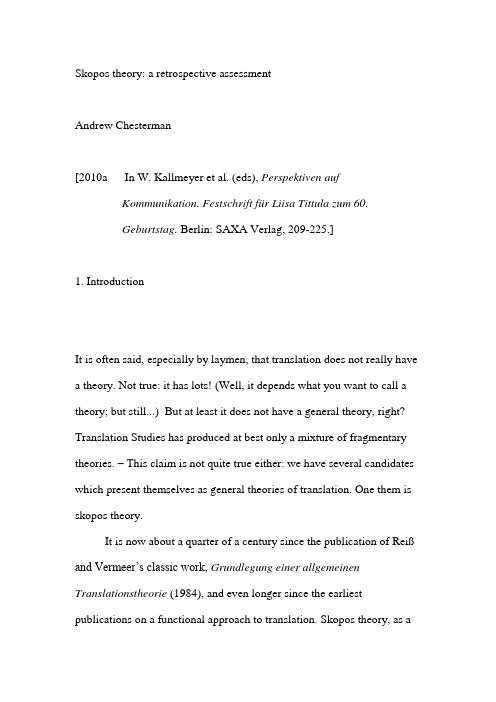
Skopos theory: a retrospective assessmentAndrew Chesterman[2010a In W. Kallmeyer et al. (eds), Perspektiven aufKommunikation. Festschrift für Liisa Tittula zum 60.Geburtstag. Berlin: SAXA Verlag, 209-225.]1. IntroductionIt is often said, especially by laymen, that translation does not really have a theory. Not true: it has lots! (Well, it depends what you want to call a theory; but still...) But at least it does not have a general theory, right? Translation Studies has produced at best only a mixture of fragmentary theories. – This claim is not quite true either: we have several candidates which present themselves as general theories of translation. One them is skopos theory.It is now about a quarter of a century since the publication of Reißand Vermeer’s classic work,Grundlegung einer allgemeinen Translationstheorie (1984), and even longer since the earliest publications on a functional approach to translation. Skopos theory, as aparticular type of general functional theory, seems fairly well established on the map of translation studies, and is duly mentioned in all the textbooks. But how well has it stood the test of time? My aim here is to offer a general retrospective assessment of the theory, also taking account of some more recent criticism.2. Axiomatic assumptionsAny theory rests on basic assumptions that are not tested within a given research paradigm, but are taken as given, self-evident, based on common sense and logic. We must start from somewhere, after all. But of course we can always query these assumptions if we wish, standing outside the paradigm. Some of them may be only implicit, hidden. But good theories aim to make all the relevant assumptions as explicit as possible, for instance as axioms from which the rest of the theoretical claims can be deduced. Skopos theory is unusual among other theories of translation, in that it has this form of a deductive, “syntactic” theory based on a small number of explicit axioms. In the 1984 version, these are called “rules” (Regeln). I give them here in summarized form (in the original German, from Reiß and Vermeer 1984: 119), followed by some brief initial explications and comments.1. Ein Translat ist skoposbedingt.2. Ein Translat ist ein Informationsangebot in einer Zielkultur und–sprache über ein Informationsangebot in einer Ausgangskulturund –sprache.3. Ein Translat bildet ein Informationsangebot nicht-umkehrbareindeutig ab.4. Ein Translat muß in sich kohärent sein.5. Ein Translate muß mit dem Ausgangstext kohärent sein.6. Die angeführten Regeln sind untereinander in der angegebenenReihenfolge hierarchisch geordnet (“verkettet”).Ad 1: Skopos theory thus assumes that a translation always has a skopos (a purpose), even though this may not always be clear (ibid.: 21). This skopos may often differ from that of the source text (surely a useful point). The skopos is the highest determining factor influencing the translator’s decisions. Elsewhere (ibid.: 96), the rule is phrased: “Die Dominante aller Translation is deren Zweck.” The theory assumes that the skopos is oriented towards to the intended target recipients: all translations have such a readership; even if you cannot always specify them, there are al ways “there” (ibid.: 85). – I will return below to problems of definition.Ad 2: The theory assumes that language is embedded in culture. Translation is seen as a subtype of more general cultural transfer (Reißand Vermeer 1984: 13). The “information offer” concept relates to the underlying theory of communication, whereby a sender “offers” information to a receiver. This information is assumed by the sender to be “interesting” to the receiver (ibid.: 76, 103), and, if the communicative act is successful, it will be interpreted by the receiver in a way that is compatible with the sender’s intention and does not give rise to a “protest” (ibid.: 67, 106).Ad 3: Translations are not normally reversible; and a given source text has many possible translations.Ad 4: Intratextual coherence is assumed to exist to the extent that the text makes sense to the receiver, that it is compatible with the receiver’s cognitive context, as in any form of communication. Note that rules 4 and 5 have a clear prescriptive form, unlike the others.Ad 5: This fidelity rule assumes that the translation represents the source text, in some way which is relevant to the skopos. The theory recognizes a range of equivalence types.Ad 6: This rule is of a different status from the others, and, as part of a general theory, problematic. We might at least want to query the order of rules 4 and 5 as being universally valid.Immediately after giving this summary, the authors claim that these rules are “probably” the only general rules of translation (ibid.: 120). All further development of the theory would then be filling in more detail, providing rules for the analysis of the target situation, establishing conditions for the selection of different translation strategies, and so on (ibid.: 85).A last initial comment: at the very beginning of the book, the authors define “theory”, quite reasonably, thus: “Unter ‘Theorie’ versteht man die Interpretat ion und Verknüpfung von ‘Beobachtungsdaten’” (ibid.: vii). This definition nevertheless seems to be rather at odds with the way they actually present their theory. The argument of the book does not start with empirical observations or inductive generalizations, but proceeds deductively. Examples are given to support claims, but many of them seem to be invented.In a later publication, Vermeer (1996: 12f) contextualizes skopos theory explicitly as a form of action theory. Here too he sets out a number of axioms (now called, in English, “theses”), as follows, ending at about the point where the previous list (above) began:1. All acting presupposes a “point of departure”, i.e. an actor’sposition in space and time, convictions, theories, etc., includingtheir respective history.2. All acting is goal-oriented.3. From a variety of possibilities [...] that action will be chosenwhich one believes one has the best reasons for choosing under the prevailing circumstances. The reason(s) may not be conscious forthe actor.4. Given the prevailing circumstances, an actor tries to reach theintended goal by what seem to him the/an optimal way, i.e., forwhich he believes he has the best overall reason(s).5. Translating is acting, i.e. a goal-oriented procedure carried out insuch a way as the translator deems optimal under the prevailingcircumstances.6. Thesis 5 is a general thesis valid for all types of translating[including interpreting].7. In translating, all potentially pertinent factors (including thesource text on all its levels) are taken into consideration as far asthe skopos of translating allows and/or demands. [Emphasisoriginal]8. The skopos of (translational) acting determines the strategy forreaching the intended goal.One might wonder about the apparent underlying assumption here that human behaviour is necessarily always rational –if these axioms aresupposed to be descriptive (on which more below). Another underlying assumption, to which we shall return, is the assumption of optimality: that the translator (always) acts in an optimal way.3. Conceptual contributionQuite apart from any other merits, a theory may contribute new concepts to a field. These may aid theoretical thinking in general, as well as description and explanation, and may be taken up and adapted by other theories. New theoretical concepts are interpretive hypotheses, to be tested pragmatically in use (see further e.g. Chesterman 2008). Two aspects of this potential conceptual contribution will be mentioned here, beginning with the central concepts themselves.3.1. Key terms and conceptual distinctionsSome of the earliest criticism of skopos theory had to do with some of its definitions, or the lack of them (see Koller 1990, on functional theories more generally; Kelletat 1986; Hebenstreit 2007). We can also ask whether the relation between the set of terms and the set of necessary concepts is an appropriate one. Are there too many terms, or too few?Skopos is said to be a synonym of Zweck (purpose)or Funktion(Reiss and Vermeer 1984: 96), but “function” itself is not explicitly defined in the same context. Perhaps it could be glossed as “intended effect”. But: effect on whom? Intended receivers, or any and all receivers? And intended by whom? Is it only the client’s intention that counts? What about the source author’s? The publisher’s? When does an effect begin, and end? What about heterogeneous effects? How do we actually measure effects? Furthermore, if skopos equals function, we may wonder why a new term is needed. Confusingly, the Germanterm Funktion is used in several senses, including the mathematical one. Two of these senses do indicate an interesting distinction: “external function” is said to denote the translator’s general o bjective of making a living, whereas “internal function” refers to the skopos of a given translation (or translation process) (ibid.: 4). This external function seems very close to the term telos proposed in Chesterman and Baker (2008), to describe a trans lator’s ideological motivation for working as a translator, either generally as a career or on some specific, perhaps chosen, assignment.Later, Vermeer (1996: 7-8) seeks to distinguish three related concepts as follows: the intention is what the client wants to do;the skopos is what the translation is for; and the function is the “text purpose as inferred, ascribed by recipient”. But there remain problemshere. Are these distinctions necessary? When might an intention clash with a skopos? Function, in particular, remains an unclear concept. Recipients are not a homogeneous set, and may well ascribe very different functions. Even a model reader may react differently on different occasions. And besides, actual reception should surely be distinguished from intended function. Both intentions and functions may be virtually impossible to access, particularly if the translations studied are distant in time or space. – The conceptual and terminological confusion here has not been resolved (see e.g. Nord 1997: 27f; Sunwoo 2007).Another problematic term is that of coherence, used both to refer to the similarity relation of equivalence between source and target, and to the intratextual interpretability of the translation itself. These seem very different concepts, and one wonders why the theory uses the same term. Since we already have “equivalence”, and this term is used in skopos theory too, why do we need a new term? We also already have “similarity”, if something looser than “equivalence” is wanted.A translation is defined in the second axiom as an offer of information about a source text (which is itself another such offer, about something else). This interpretation of the relation between source and target is much weaker than any notion of equivalence, weaker even than relevant similarity (although Reiss and Vermeer do refer occasionally tothe offer as being a “simulating” one, e.g. p. 80, 105). It does not appear to constrain the “offer” in any way, except insofar as the offer is assumed to be “interesting” to the receivers and is “coherent” with the source text. Here again we can ask: does this term really earn its place?Regarding the German term Translation itself, we can appreciate the way in which skopos theory (following a German tradition in Translation Studies) uses this to cover both written and oral translation: this is a neat solution we have not managed to imitate in English, and which has subsequently been widely accepted. There will, however, always be argument about the appropriate extension of the term. Kelletat (1986) and Koller (1990) think the skopos notion of translation is too broad because of the way it downgrades the importance of the source text and thus allows very free translations, adaptations etc., within the concept. Kelletat (1986: 15) even suggests the Reiss/Vermeer definition would include the whole of Latin literature! In my view, on the contrary, it is too narrow, if it is taken to exclude non-optimal translations.The theory’s use of the term “adequacy” (Adäquatheit) also merits a comment. The term was already familiar from other approaches, particularly Toury’s (e.g. 1980). But skopos theory defines it differently, not as a retrospective relation of closeness between target and source but as a prospective one between the translation, the source text and the skopos (Reiss and Vermeer 1984: 139). This skopos-sense of adequacy isso easily confused with the Toury-sense that scholars now either have to specify which sense is intended or give up using the term altogether. It is risky to give a new sense to an already established term.Skopos theory, like other functional approaches, has also contributed to a more differentiated conceptualization of the agents involved in the translation process. Instead of simply having a sender and a receiver, we have learned to distinguish between writer, client, translator, publisher, recipient, addressee and so on. In this sense, skopos theory has helped to shift the discipline towards a more sociological approach.3.2. Underlying metaphorical structureA good theory’s concepts do not exist in isolation, but in a network of relations. This network may be more or less consistent in terms of its metaphorical structure. Martín de León (2008) has recently drawn attention to some interesting problems in the underlying metaphorical conceptualization of skopos theory. She argues that the theory combines two different metaphors: TRANSFER and TARGET. This suggests a lack of conceptual consistency, insofar as the metaphors are incompatible.The TRANSFER metaphor describes the movement of an object from A to B, and assumes that the object (or some essence of it) does notchange en route. This means assuming some kind of equivalence, of course. As an underlying metaphor for translation (visible in the etymology of this word), it normally needs to reify some notion of meaning (referred to as the message in Holz-Mänttäri 1984). The client’s intention might also be regarded as an “object” that is to be preserved. However, the view of a translation as merely an “offer of information” about the source text appears to go against the TRANSFER metaphor.The theory’s notion of intertextual coherence also relates to this metaphor, albeit loosely. But how valid is this assumption that meaning is “there” in the text? Several contemporary models of cognition would argue that meaning always emerges via a process of interpretation, a process which depends on multiple variables and is not completely predictable (see e.g. Risku 2002). – In my view, both these positions are overstated. Surely some meanings are more obviously, objectively “there” in a text, while others are much less so and are open to interpretive variation. If no meanings were objectivizable at all, there would be no work for terminologists and no-one would dare to step into a plane.The TARGET metaphor on the other hand describes a process from a source along a path to a goal. It does not assume an unchanged, reified message. It implies that the translator can participate in constructing the meaning of the message and thus highlights notions ofintentionality and rationality. Skopos theory stresses the expertise and responsibility of the translator to select what needs to be translated and to translate it in the most appropriate manner. But this metaphor also prompts questions. Suppose a given process or action does not have a single goal but multiple ones, perhaps regarding heterogeneous receivers? And where actually is a goal located? Strictly speaking, the goal is not in the text but in the mind of the initiating agent, for whom the translation is merely a means to achieve a goal or goals. Further: where in the theory is there any space for an assessment of the goals themselves? Is it really enough to say that any end justifies the means? – We will take up the ethical dimension of this argument below.4. Ontological status of the theoryPerhaps the most debated problem of skopos theory has been its unclear ontological status. Does it aim to be a descriptive theory (of what is) or a prescriptive one (of what should be)? Does it describe a real world or an ideal, optimal one?This ambiguous status is already apparent in its axioms: axioms four and five are openly prescriptive, but the others are not. Reiss and Vermeeer say that there is no such thing as “the best” translation for agiven source text. “Es gibt nur das Streben nach Optimierung unter den jeweils gegebenen aktuellen Bedingungen” (1984: 113). – This is an interesting formulation. The “es gibt” looks like an existential, descriptive claim: it is a fact that translators strive, that they do their best. Well, how valid is this fact? We could reply that good translators do indeed do their best, most of the time, but surely there must also be many translators who merely do the minimum, at least sometimes. Professionals must often satisfice, after all. And there are many bad translators, of course (if a translator is anyone who does a translation, as a general theory should surely assume).It seems to me to be clear that skopos theory is essentially prescriptive, although it has some descriptive assumptions. It aims to describe how good translators, expert professionals, work; what good translations are like. It describes an ideal world (see also Chesterman 1998). Vermeer has acknowledged this (Chesterman 2001), saying that the theory seeks to describe optimal cases. Elsewhere, however, he also seems to suggest that functional theories in general are both descriptive and prescriptive:Skopos theory is meant to be a functional theoretical general theory covering process, product and, as the name says, function both ofproduction and reception. As a functional theory it does not strictlydistinguish between descriptive and (didactic) prescription.(Vermeer 1996: 26n)Although the term “functional” remains problematic, I find this claim curious. Consider for instance the analysis of the reception of translations in a given culture in a given period. This would be an analysis of how the translations “functioned” in the target culture (data might include all kinds of responses, critical reviews, library loans, size and number of editions published, allusions to the translations in other writings, use of the translations as source texts for further translations, or as literary influences; sales of commercial products advertised by the translations; changes in the social, political, religious or ideological conditions; and so on). The analysis would not need to be prescriptive in any way. Even if the analysis compared the reception with the inferred intentions of different clients, this would not imply a prescriptive approach.On the other hand, there is one obvious way in which prescriptive claims can be viewed descriptively, and that is by formulating them as predictive hypotheses, as argued in Chesterman (1999). Vermeer actually does precis ely this at one point (1996: 31): “if you translate in such and such a way then y will happen”. Such predictions can then be tested in the normal way, and the results can be generalized in the form of guidelines which, if followed, are reliablyassumed to lead to translations which do not give rise to negative feedback (“Protest” in skopos-theoretical terms). This, of course, is precisely what translator training courses teach. It is also what skopos theory aims to do. If you keep the skopos in mind, and translate accordingly, the result will be better than if you neglect the skopos.5. Empirical status of the theoryAs presented, skopos theory is not founded on a search for empirical regularities. This point has been made by many critics (e.g. Koller 1995: 215). We can nevertheless consider how its various assumptions and claims might be tested empirically. It is striking that very little such testing has actually been done. What kind of evidence would falsify or weaken its claims? I will f irst consider the theory’s descriptive adequacy, then comment on its explanatory adequacy and possible testable consequences.5.1. Descriptive adequacyAxioms two and three in the original list above are descriptive. Axiom two, on translation as an offer of information, is definitional. It is aninterpretive hypothesis, which can be glossed something like this: ‘in this theory, we claim that a translation is usefully interpreted as ...’. As such, the claim is not falsifiable, but is testable pragmatically, i.e. in use (see further Chesterman 2008). Has this interpretation been widely adopted and led to further hypotheses? Not notably, it seems. On the contrary, it has aroused some criticism, as it seems to allow the concept of translation to expand too far (e.g. Kelletat 1986).Axiom three states that translations are not reversible. This claim can certainly be tested empirically, via back-translation. In my view, the claim is too extreme. It would surely be more accurate to say that the smaller the unit of translation, the more reversible it is; that in cases of standardized translations – e.g. in multilingual glossaries of special fields or in the names of institutions, or in many idioms and proverbs, in numbers, etc. – reversibility may well be the norm. In other words, the claim needs to be restricted, made subject to other conditional factors such as size of translation unit, text type, skopos, and so on.There have been a few empirical studies recently which question some of the other basic assumptions of skopos theory. Koskinen (2008) examines the working conditions of EU translators. One of her findings is that in many cases, EU translations that are not intended for the general public are not directed at a target culture at all, but are oriented by the needs of the source institution (99-100). This goes against the skopostheory assumption that a translation should have optimal functionality for target culture addressees. However, this type of EU case is not evidence against the idea that a translation is primarily determined by its skopos. Here, the skopos is simply not a target-oriented one. Interestingly, Koskinen points out that the special requirements of this kind of translation are experienced as particularly problematic by translators who have been trained in a functional approach: their translation brief seems to conflict with the target-oriented way in which they have been trained to think.Furthermore, many professional translators do not work as autonomous individuals but as members of a team of experts, including terminologists, subject specialists, revisers, copyeditors and so on. Such conditions do not always support the skopos theory assumption that it is the translator who ultimately decides how to translat e, as the expert. (“Er entscheidet letzten Endes, ob, was, wie übersetzt/gedolmetscht wird.” Reiß and Vermeer 1984: 87.) One recent study illustrates this well: Nordman (2009) examines the complex process of Finnish-Swedish translation in the bilingual Finnish Parliament, and highlights interesting disagreements between the translator’s preferences and those of revisers or legal experts, and how these are resolved. The translators and revisers she studied seem to have different norm priorities. It is not always the translator’s views that prevail.Even in some literary translation the priority of the translator’s expertise has been questioned. In a questionnaire study dealing with poetry translation, Flynn (2004) queries the status of some of the factors which skopos theory assumes, including that of the dominance of the translator’s own expertise. Flynn found that the situational factors affecting the final form of the translation are more like sites of confrontation between the various agents involved, including publishers and proof-readers as well as translators. The translator does not necessarily always have the final say. Flynn’s results admittedly concern a particular type of translation only, in a particular (Irish) context; but again, we can point out that a general theory should be able to cope with all types.As another example of evidence against the assumption that it is the expert translator who makes the final decisions I cite an ongoing PhD project by Julia Lambertini Andreotti at Tarragona. She is a qualified court interpreter working with Spanish and English in California. The ethical code there requires that interpreters make no alteration to the register of the legal jargon as they translate. But since many of the clients are not well educated, they simply do not understand the legal terminology, and so do not understand what they are asked. As communication experts, the interpreters naturally wish to adapt theregister so that the clients can understand, but this is not allowed. The interpreters are simply not permitted to act as skopos theory assumes.One might argue that all such examples are cases where a translator is forced to act under duress, against the council of his own expertise, and thus in non-optimal conditions. They would thus fall outside the scope of skopos theory. Reiß and Vermeer explicitly exclude instances of “Translation unter Zwang” (1984: 101). – But there are multiple kinds and grades of duress, including unrealistic deadlines, legal constraints etc., which characterize much real-world translation and interpreting. Indeed, if there are in fact more non-optimal cases than optimal ones, skopos theory itself would deal only with special cases – surely not the intention of the skopos theorists. A general theory should be general enough to encompass all cases.From another point of view, note should be taken of studies on how translators perform under time pressure (e.g. Hansen 2002). These studies suggest that when professional experts work under unusual time pressure, they tend not to waste time pondering about the skopos or the target audience but simply stay on the surface of the text, translating fairly literally, without reformulations or other major shifts which might actually be appropriate for the readership. Here again we have professionals working in a non-optimal situation, without sufficient timefor normal working procedures. Under these conditions, the skopos assumptions seem not to represent what actually happens.Research such as these studies underlines the way in which skopos theory relates more to an ideal, optimal world than to the real and often suboptimal world of everyday translation. In this sense, some of the general descriptive claims and assumptions of the theory can easily be falsified, or forced into more conditioned formulations – if they are supposed indeed to apply to all translation, not just optimal translation done in optimal working conditions. And what about the undeniable existence of a great many really bad translations? These are nonetheless also translations, of a kind; but they are completely excluded from skopos theory. From the point of view of descriptive adequacy, then, the theory is inadequate. But if it is taken as a prescriptive theory, of course, this is not a valid criticism.5.2. Explanatory adequacyThe first axiom (in the German list above) is a causal one. From the point of view of the production of a translation, it states that the skopos is the most important conditioning factor. This has obvious prescriptive relevance. But retrospectively, as an answe r to the question “why is this。
功能翻译理论目的论
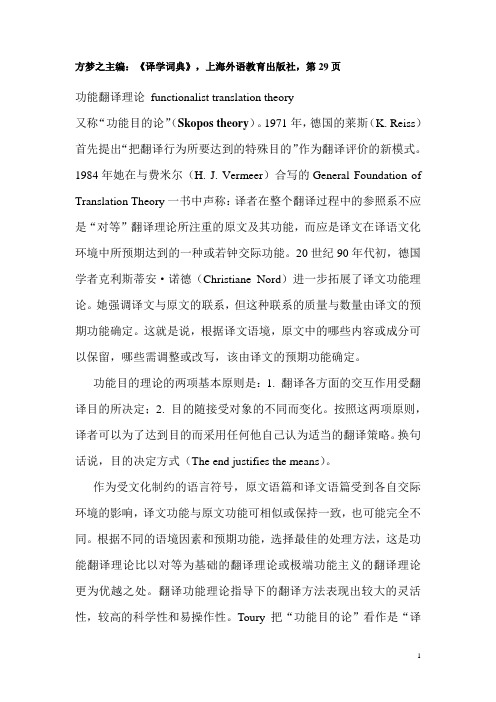
方梦之主编:《译学词典》,上海外语教育出版社,第29页功能翻译理论functionalist translation theory又称“功能目的论”(Skopos theory)。
1971年,德国的莱斯(K. Reiss)首先提出“把翻译行为所要达到的特殊目的”作为翻译评价的新模式。
1984年她在与费米尔(H. J. Vermeer)合写的General Foundation of Translation Theory一书中声称:译者在整个翻译过程中的参照系不应是“对等”翻译理论所注重的原文及其功能,而应是译文在译语文化环境中所预期达到的一种或若钟交际功能。
20世纪90年代初,德国学者克利斯蒂安·诺德(Christiane Nord)进一步拓展了译文功能理论。
她强调译文与原文的联系,但这种联系的质量与数量由译文的预期功能确定。
这就是说,根据译文语境,原文中的哪些内容或成分可以保留,哪些需调整或改写,该由译文的预期功能确定。
功能目的理论的两项基本原则是:1. 翻译各方面的交互作用受翻译目的所决定;2. 目的随接受对象的不同而变化。
按照这两项原则,译者可以为了达到目的而采用任何他自己认为适当的翻译策略。
换句话说,目的决定方式(The end justifies the means)。
作为受文化制约的语言符号,原文语篇和译文语篇受到各自交际环境的影响,译文功能与原文功能可相似或保持一致,也可能完全不同。
根据不同的语境因素和预期功能,选择最佳的处理方法,这是功能翻译理论比以对等为基础的翻译理论或极端功能主义的翻译理论更为优越之处。
翻译功能理论指导下的翻译方法表现出较大的灵活性,较高的科学性和易操作性。
Toury 把“功能目的论”看作是“译文文本中心论”的翻版。
Skopos theory (plural Skopos theories)1.(translation studies) The idea that translating and interpretingshould primarily take into account the function of both the sourceand target text.o1995, Paul Kussmaul, Training The Translator, JohnBenjamins Publishing Co, p. 149:The functional approach has a great affinity with Skopos theory.The function of a translation is dependent on the knowledge,expectations, values and norms of the target readers, who are again influenced by the situation they are in and by the culture. Thesefactors determine whether the function of the source text orpassages in the source text can be preserved or have to be modified or even changed.Introduction to the Skopos TheoryThe Skopos theory is an approach to translation which was put forward by Hans Vemeer and developed in Germany in the late 1970s and whichoriented a more functionally and socioculturally concept of translation. Translation is considered not as a process of translation, but as a specific form of human action. In our mind, translation has a purpose, and the word “Skopos” was from Greek. It’s used as the technical term for the purpose of the translation.翻译目的论,"skopos"是希腊语“目的”的意思。
如何用目的论评析译文

如何用目的论评析译文
目的论(Skopos Theory)是翻译理论中的一个重要概念,它认为翻译是有目的的行为,译文应该在目标文化中实现预期的功能。
下面是如何用目的论来评析译文的一些步骤:
1.确定翻译目的:首先,需要明确译文的目的是什么。
例如,是为了传达信息、促进文化
交流、诱导行动还是表达情感。
2.分析目标受众:了解目标受众的特点,包括他们的文化背景、知识水平、阅读习惯等,
以便更好地选择适当的翻译策略和表达方式。
3.对比原文和译文:比较原文和译文在信息传递、语言风格、文化内涵等方面的差异,看
是否在目标文化中实现了预期的功能。
4.评估译文效果:根据目标受众的反应和译文的实际效果,评估译文的准确性和可接受
度,以及是否达到了预期的目的。
5.总结和反思:对整个翻译过程进行总结和反思,总结经验和教训,进一步提高自己的翻
译水平和能力。
在使用目的论评析译文时,需要注意以下几点:
1.尊重原文:在翻译过程中,要尊重原文的意思和风格,尽可能地保留原文的精髓和特
点。
2.考虑目标文化的特点:在翻译过程中,需要考虑目标文化的特点和受众的需求,采用适
当的语言风格和文化表达方式。
3.注重信息的准确性和完整性:在翻译过程中,要确保信息的准确性和完整性,避免出现
误译或漏译的情况。
4.评估译文的实用性和效果:在评析译文时,需要评估译文的实用性和效果,看是否能够
满足目标受众的需求和实现预期的目的。
浅析翻译目的论三原则及其在翻译实践中的应用

浅析翻译目的论三原则及其在翻译实践中的应用一、概述翻译目的论,作为一种重要的翻译理论,起源于20世纪70年代的德国,由汉斯弗米尔(Hans J. Vermeer)提出,并由其学生克里斯蒂娜诺德(Christiane Nord)进一步发展和完善。
翻译目的论强调翻译行为的目的性,认为翻译是一种有目的的跨文化交际活动,其首要原则是翻译行为所要达到的目的决定整个翻译过程。
这一理论突破了传统等值理论的束缚,为翻译研究和实践提供了新的视角。
翻译目的论提出了三大原则:目的原则、连贯原则和忠实原则。
目的原则是指翻译行为所要达到的目的决定整个翻译过程,即翻译的方法与策略必须服务于翻译的目的。
连贯原则要求译文必须符合语内连贯的标准,即译文具有可读性和可接受性,能够使接受者理解并在译入语文化及使用译文的交际语境中有意义。
忠实原则是指原文与译文之间应该存在语际连贯一致。
这三大原则在翻译实践中具有指导意义,能够帮助译者根据不同的翻译目的选择合适的翻译策略和方法。
本文将对翻译目的论的三大原则进行浅析,并探讨它们在翻译实践中的应用。
通过具体案例分析,展示如何根据不同的翻译目的,灵活运用这些原则,以实现有效的跨文化交际。
同时,本文还将对翻译目的论在翻译实践中的意义进行探讨,以期对翻译实践和研究提供有益的启示。
1. 翻译目的论概述翻译目的论,作为一种重要的翻译理论,起源于20世纪70年代的德国功能主义翻译理论。
该理论主张翻译活动应以实现特定的翻译目的为核心,强调翻译过程中译者的主观能动性和译文的预期功能。
翻译目的论突破了传统等值翻译理论的束缚,提出了以翻译目的为导向的翻译原则和方法。
在翻译目的论中,翻译被视为一种有目的的跨语言、跨文化的交际行为。
翻译的目的可能因文本的不同而有所不同,如信息传递、文化交流、商业推广等。
翻译过程中,译者应根据翻译目的选择合适的翻译策略和方法,以确保译文能够有效地实现预期的交际功能。
翻译目的论提出了三个基本原则,即目的原则、连贯性原则和忠实性原则。
浅析翻译目的论在翻译实践中的应用
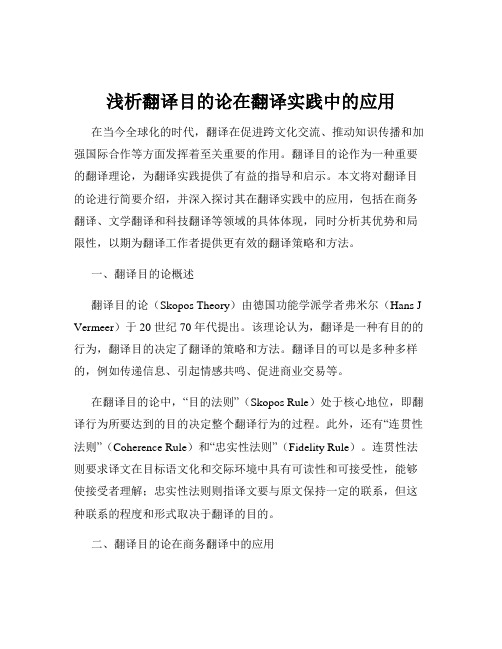
浅析翻译目的论在翻译实践中的应用在当今全球化的时代,翻译在促进跨文化交流、推动知识传播和加强国际合作等方面发挥着至关重要的作用。
翻译目的论作为一种重要的翻译理论,为翻译实践提供了有益的指导和启示。
本文将对翻译目的论进行简要介绍,并深入探讨其在翻译实践中的应用,包括在商务翻译、文学翻译和科技翻译等领域的具体体现,同时分析其优势和局限性,以期为翻译工作者提供更有效的翻译策略和方法。
一、翻译目的论概述翻译目的论(Skopos Theory)由德国功能学派学者弗米尔(Hans J Vermeer)于 20 世纪 70 年代提出。
该理论认为,翻译是一种有目的的行为,翻译目的决定了翻译的策略和方法。
翻译目的可以是多种多样的,例如传递信息、引起情感共鸣、促进商业交易等。
在翻译目的论中,“目的法则”(Skopos Rule)处于核心地位,即翻译行为所要达到的目的决定整个翻译行为的过程。
此外,还有“连贯性法则”(Coherence Rule)和“忠实性法则”(Fidelity Rule)。
连贯性法则要求译文在目标语文化和交际环境中具有可读性和可接受性,能够使接受者理解;忠实性法则则指译文要与原文保持一定的联系,但这种联系的程度和形式取决于翻译的目的。
二、翻译目的论在商务翻译中的应用商务翻译涉及合同、商务信函、产品说明书等多种文本类型,其目的通常是为了促进商务活动的顺利进行和达成交易。
在商务翻译中,翻译目的论的应用主要体现在以下几个方面:1、术语的准确翻译商务领域有大量的专业术语,准确翻译这些术语对于传达准确的商务信息至关重要。
翻译目的决定了术语翻译的方法。
例如,如果翻译的目的是为了让目标读者快速理解文本的主要内容,对于一些复杂的术语可以采用意译的方法,用通俗易懂的语言进行解释;如果是为了保持法律文件的严谨性和权威性,则可能需要采用直译或音译加注释的方法,以确保术语的准确性和专业性。
2、文化适应不同国家和地区在商务文化方面存在差异。
功能翻译理论Skopos theory
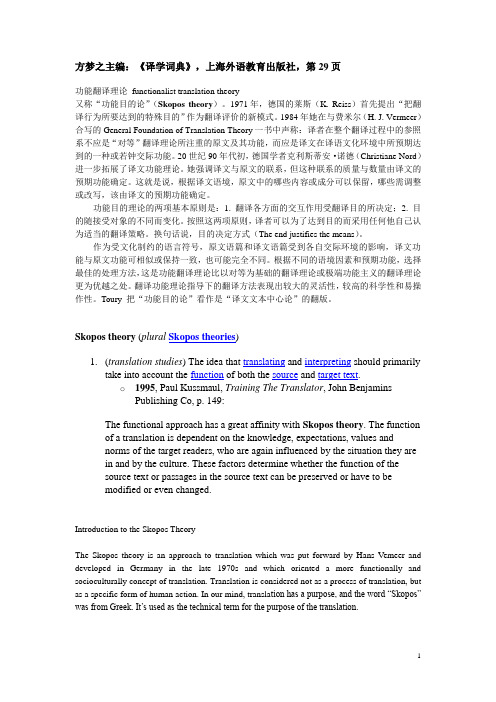
方梦之主编:《译学词典》,上海外语教育出版社,第29页功能翻译理论functionalist translation theory又称“功能目的论”(Skopos theory)。
1971年,德国的莱斯(K. Reiss)首先提出“把翻译行为所要达到的特殊目的”作为翻译评价的新模式。
1984年她在与费米尔(H. J. Vermeer)合写的General Foundation of Translation Theory一书中声称:译者在整个翻译过程中的参照系不应是“对等”翻译理论所注重的原文及其功能,而应是译文在译语文化环境中所预期达到的一种或若钟交际功能。
20世纪90年代初,德国学者克利斯蒂安·诺德(Christiane Nord)进一步拓展了译文功能理论。
她强调译文与原文的联系,但这种联系的质量与数量由译文的预期功能确定。
这就是说,根据译文语境,原文中的哪些内容或成分可以保留,哪些需调整或改写,该由译文的预期功能确定。
功能目的理论的两项基本原则是:1. 翻译各方面的交互作用受翻译目的所决定;2. 目的随接受对象的不同而变化。
按照这两项原则,译者可以为了达到目的而采用任何他自己认为适当的翻译策略。
换句话说,目的决定方式(The end justifies the means)。
作为受文化制约的语言符号,原文语篇和译文语篇受到各自交际环境的影响,译文功能与原文功能可相似或保持一致,也可能完全不同。
根据不同的语境因素和预期功能,选择最佳的处理方法,这是功能翻译理论比以对等为基础的翻译理论或极端功能主义的翻译理论更为优越之处。
翻译功能理论指导下的翻译方法表现出较大的灵活性,较高的科学性和易操作性。
Toury 把“功能目的论”看作是“译文文本中心论”的翻版。
Skopos theory (plural Skopos theories)1.(translation studies) The idea that translating and interpreting should primarilytake into account the function of both the source and target text.o1995, Paul Kussmaul, Training The Translator, John BenjaminsPublishing Co, p. 149:The functional approach has a great affinity with Skopos theory. The function of a translation is dependent on the knowledge, expectations, values andnorms of the target readers, who are again influenced by the situation they arein and by the culture. These factors determine whether the function of thesource text or passages in the source text can be preserved or have to bemodified or even changed.Introduction to the Skopos TheoryThe Skopos theory is an approach to translation which was put forward by Hans Vemeer and developed in Germany in the late 1970s and which oriented a more functionally and socioculturally concept of translation. Translation is considered not as a process of translation, but as a specific form of human action. In our mind, transla tion has a purpose, and the word “Skopos” was from Greek. It’s used as the technical term for the purpose of the translation.翻译目的论,"skopos"是希腊语“目的”的意思。
功能主义翻译目的论在中国的传播与发展
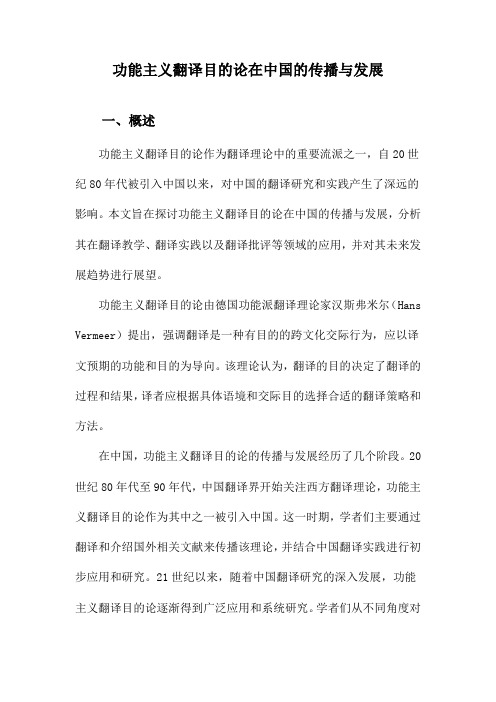
功能主义翻译目的论在中国的传播与发展一、概述功能主义翻译目的论作为翻译理论中的重要流派之一,自20世纪80年代被引入中国以来,对中国的翻译研究和实践产生了深远的影响。
本文旨在探讨功能主义翻译目的论在中国的传播与发展,分析其在翻译教学、翻译实践以及翻译批评等领域的应用,并对其未来发展趋势进行展望。
功能主义翻译目的论由德国功能派翻译理论家汉斯弗米尔(Hans Vermeer)提出,强调翻译是一种有目的的跨文化交际行为,应以译文预期的功能和目的为导向。
该理论认为,翻译的目的决定了翻译的过程和结果,译者应根据具体语境和交际目的选择合适的翻译策略和方法。
在中国,功能主义翻译目的论的传播与发展经历了几个阶段。
20世纪80年代至90年代,中国翻译界开始关注西方翻译理论,功能主义翻译目的论作为其中之一被引入中国。
这一时期,学者们主要通过翻译和介绍国外相关文献来传播该理论,并结合中国翻译实践进行初步应用和研究。
21世纪以来,随着中国翻译研究的深入发展,功能主义翻译目的论逐渐得到广泛应用和系统研究。
学者们从不同角度对该理论进行了阐释、应用和拓展,丰富了中国翻译理论的内涵。
本文将通过对相关文献的梳理和分析,探讨功能主义翻译目的论在中国的传播与发展历程,总结其在翻译教学、翻译实践以及翻译批评等领域的应用经验和研究成果,并对其未来发展趋势进行展望,以期为推动中国翻译研究和实践的发展提供有益参考。
1. 介绍功能主义翻译目的论的基本概念功能主义翻译目的论是一种重要的翻译理论,起源于20世纪70年代的德国,由汉斯弗米尔(Hans J. Vermeer)和凯瑟琳娜莱斯(Katharina Reiss)等学者提出并发展。
该理论强调翻译的目的和翻译过程中各种因素之间的互动关系,认为翻译是一种有目的的交际行为,翻译策略和方法的选择应该根据翻译的目的和读者需求来确定。
在功能主义翻译目的论的框架下,翻译不再被看作是简单的语言转换,而是一种跨文化、跨语言的交流活动,其最终目的是实现特定的交际功能。
skopos-theory翻译功能目的论.
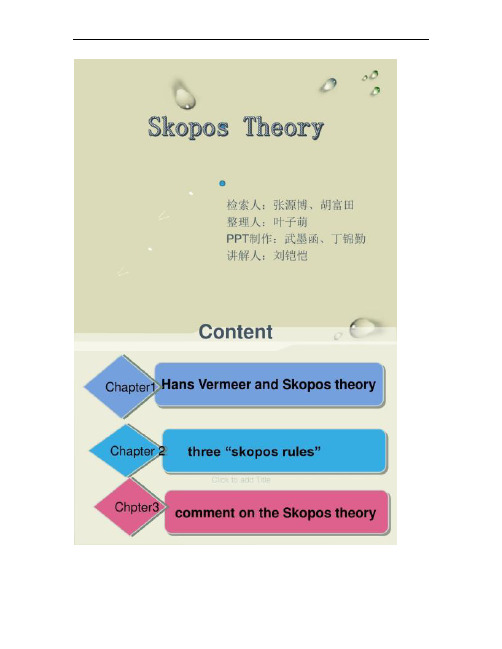
• • Objection 1 It neglected the source text too much, especially in terms of the ST’s linguistic features below text level. • It is argued that, even though a translation may indeed fulfil its intended skopos perfectly well, it may nevertheless be assessed as inadequate on other counts, particularly as far as lexical, syntactic, or stylistic decisions on the microlevel are concerned ( Chesterman 1994:153. • 目的论对原文语言特色的关注不够,对译文在微观层面上的特点的关注也不够。
翻译目的即使得到实现,个别地方在风格和语义层面上仍可能是不充分的。
•Objection 2 • Vermeer’s cultural approach has also been judged less applicable to literary translation, due to the special status of a literary work of art. • 目的论只对非文学文本有效,文学文本要么没有具体目的,要么风格太复杂;
• Objection 3 • 功能理论导致惟利是图译者的产生。
译者在翻译目的主导翻译过程的思想下,为了获取酬金,有可能不顾原文进行翻译。
- 1、下载文档前请自行甄别文档内容的完整性,平台不提供额外的编辑、内容补充、找答案等附加服务。
- 2、"仅部分预览"的文档,不可在线预览部分如存在完整性等问题,可反馈申请退款(可完整预览的文档不适用该条件!)。
- 3、如文档侵犯您的权益,请联系客服反馈,我们会尽快为您处理(人工客服工作时间:9:00-18:30)。
Content
Chapter1 Hans Vermeer and Skopos theory
Chapter 2
three “skopos rules”
Click to add Title
Chpter3
comment on the Skopos theory
The Fidelity Rule 忠实准则
• Fidelity rule (Intertextual Coherence) : a translation should be as faithful as possible to the original. • 忠实准则是指原文和译文中应该存在某种对应关系, 并 不要求原文和译文在内容上一字不差。 • There must be an inter-textual coherence between the source texts and target texts, which is similar to the fidelity to the source texts.
three “skopos rules”
Coherence (Intra-texual Coherence) 连贯规则
The Fidelity rule( Inter-textual Coherence) 忠实规则/互文连贯性
目的准则
• 目的准则指翻译应能在译语情境和文化中,按译 语接受者期待的方式发生作用。决定翻译过程的 根本原则是整个翻译活动的目的(skopos),即 “结果决定方法”。这种目的有三种解释:1)译 者的基本目的;2)译文的交际目的;3)特定翻 译策略或手段要达到的目的。但通常“目的”是 指译文的交际目的。即翻译过程的发起者,决定 译文的交际目的,发起者出于某一特殊需要,在 理想状况下,他会给出需要译文的原因,译文接 受者、使用译文的环境、译文应具有的功能以及 与原因有关的细节等。所有这些构成了“翻译要 求”。
There is no such thing as time travel. 你穿越剧看多了吧。 原意是“穿越这种事根本就不存在啊。”“穿越剧” 在国内观众中是比较流行的剧种,译者直接用 “穿越剧”来指代“穿越”。产生幽默的作用
Chapter 2 目的论的基本原则
The Skopos rule 目的规则
• 例1. Waterloo Bridge《魂断蓝桥》(直译为滑铁卢桥)
• 不仅避开了中国观众由于地域文化差异、历史背景知识缺 乏而引起的迷惑;而且蓝桥蕴含着中国文化的特色,与牛郎 织女的鹊桥相会相仿,能够使观众一看到片名就能心领神 会,而且具有很高的审美价值。译者要把握观众的审美需 求,达到形式美和内容美的统一以及要考虑到观众的心理 需求。最终在实现电影片名翻译的目的:吸引观众看电影。
大王有令,有破刺客长空者,赏千金,封千户侯。 By order of His Majesty, he who kills Sky will receive gold and land. 这句台词中,千金,千户侯都含有文化信息,若全部保留文化信 息,其译文应该是: By order of His Majesty, he who kills Sky will be awarded one thousand tales of gold and be dubbed marquis (爵候, 世袭贵族)with a possession of one thousand households
Part 2 翻译目的论的产生背景 • In 1970s, with the pragmatic turn both in linguistics (leading to a pragmatics-based text theory) and literary theory (leading to reception aesthetics text theory) as well as communication theory in mind, Vermeer and other Skopos scholars started to view translation as a purposeful intercultural communicative acting between individuals instead of something that is done to a text by a translator.
• Having been trained as an interpreter by Katharina Reiss, Vermeer took up general linguistics, then translation studies and also desired to break with linguistic translation theory by proposing a new translation theory. • Skopostheorie is explained in detail in the book A Framework for a General Translation Theory co-authored by Vermeer and Reiss in 1984.
Coherence 连贯准则
• Coherence (Intratextual Coherence) : a translation should be acceptable in a sense that it is coherent with the receivers’ situation, being part of the receivers’ situation. • 连贯准则是指译文必须考虑接受者的背景知识和实际情况, 最大限度地做到语义连贯, 以便译文接受者能够理解其义符 合译入语的表达习惯。 • The target text must be translated in such a way that it is coherent for the target receivers, given their circumstances and knowledge. Translator should conform to the cannons and ethnic rules in the target language and culture, and reproduce the information offered in the source text in an acceptable and accessible way to the target reader, taking their background knowledge and situational circumstances into account.
举例 • We care to provide service above and beyond the call of duty.-ups • 一问:殷勤有加,风雨不改(UPS快递) • 若直译这则广告,应是“我们愿意提供高 于或者超出责任感的服务”。虽然译文在 语义和词义上都属于忠诚对等翻译,但四 字结构“殷勤有加,风雨不改”更能向目 的与消费者传达该公司的服务精神,达到 意义上的忠诚,是广告在目标文化的诱惑 功能得以最大程度地实现。
Skopos theory
translation is a kind of action that has a purpose. • The focal points of this theory lie in three aspects: substance of translation, participants of the process of translation and principles of functional concept of translation. • It introduced the idea that a translation should always be conducted to fulfil the purpose of theTT(target text) in the TT’s situation. • The prime principle determining any translation process is the purpose (Skopos) of the overall translational action.
Relationships between the three rules
It seems that Vermeer prescribes the hierarchical rule in line with action theory and literary reception theory: the Skopos is the boss, intratextual coherence the second and fidelity the lowest; the last two rules are subordinated to the Skopos of the translation. • 忠实准则服从于连贯准则,而这二者服从 于目的准nd Skopos theory
Part 1 Hans vermeer
• Prof. Dr. h.c. Hans-Josef Vermeer (September 24, 1930 - Heidelberg, February 4, 2010), German linguist and translation scholar. • He was appointed Professor of General and Applied Linguistics at the University of Mainz in Germersheim (1971–1983). After that he held the chair of Translation Studies with special reference to Portuguese at Heidelberg University (1984–1992). He was also a visiting professor at Leopold Franzens University in Innsbruck (1999–2002), Bosphorus University in Istanbul (2002–2003) and Okan University in Istanbul (2004– 2008). He finally returned to the universities of Mainz and Heidelberg to teach in his final years. • He established the skopos theory.
